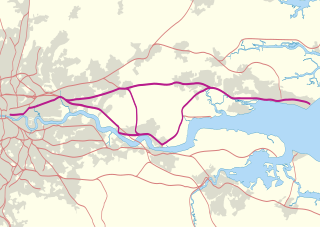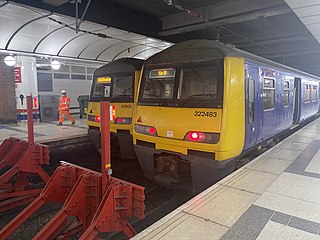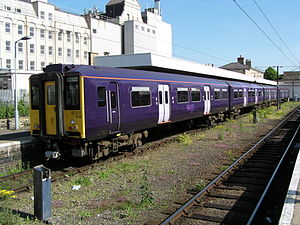
Thameslink is a 24-hour main-line route in the British railway system, running from Bedford, Luton, St Albans City, Peterborough and Cambridge via central London to Sutton, Orpington, Sevenoaks, Rainham, Horsham, Brighton and East Grinstead. The network opened as a through service in 1988, with severe overcrowding by 1998, carrying more than 28,000 passengers in the morning peak. All the services are currently operated by Govia Thameslink Railway.

Anglia Railways was a train operating company in England, owned by GB Railways and later FirstGroup, that operated the Anglia franchise from January 1997 until March 2004.

c2c is a British train operating company owned by Trenitalia that operates the Essex Thameside railway contract. It manages 25 stations and its trains call at 28. c2c provides commuter services from its London Fenchurch Street terminus to parts of East London and south Essex along the London, Tilbury and Southend line. At weekends it also operates from London Liverpool Street.

National Express East Anglia (NXEA) was a train operating company in England owned by National Express that operated the Greater Anglia franchise from April 2004 until February 2012. Originally trading as One, it was rebranded National Express East Anglia in February 2008. It provided local, suburban and express services from London Liverpool Street to destinations in Essex, Hertfordshire, Cambridgeshire, Suffolk and Norfolk in the East of England.

The Stansted Express is a direct train service linking London Liverpool Street to London Stansted Airport. It is a sub-brand of Greater Anglia, the current franchise operator of the East Anglia franchise.

Tottenham Hale is a National Rail and London Underground interchange station located in Tottenham Hale in north London, England. On the National Rail network it is on the West Anglia Main Line, 6 miles (9.7 km) from London Liverpool Street, and is served by Greater Anglia and Stansted Express. On the Underground it is on the Victoria line between Blackhorse Road and Seven Sisters. The station is in Travelcard Zone 3.
A train operating company (TOC) is the term used on the railway system of Great Britain for a railway undertaking operating passenger trains under the collective National Rail brand. TOCs have existed since the privatisation of the network under the Railways Act 1993.

The British Rail Class 170 Turbostar is a British diesel multiple unit (DMU) passenger train built by Adtranz and later Bombardier Transportation at Derby Litchurch Lane Works. Introduced after privatisation, these trains operate regional as well as long-distance services, and to a lesser extent suburban services. A total of 139 units were built, but some were later converted to Class 168 and Class 171 units. These trains are currently in use with CrossCountry, East Midlands Railway, Transport for Wales Rail, ScotRail and Northern Trains.

The British Rail Class 317 is an electric multiple unit (EMU) passenger train constructed by British Rail Engineering Limited in two batches, 48 sets being produced in 1981–82 and 24 sets in 1985–87. They were the first of several classes of British Rail EMU to be based on the all-steel Mark 3 bodyshell, departing from the "PEP"-aluminium design which had spawned the earlier Class 313 to Class 315, Class 507 and Class 508. The Mark 3 bodyshell was also the basis of Class 318, Class 455, and the diesel Class 150. The Class 317 uses overhead alternating current electrification.

The British Rail Class 365 Networker Express was a class of dual-voltage electric multiple-unit passenger train built by ABB at Holgate Road Carriage Works in 1994 and 1995 to operate services in South East England and on the Great Northern Route. These were the last trains to be built at the Holgate Road works before its closure. Due to the refurbished front end resembling a smiling face, the trains were nicknamed "Happy Trains" by enthusiasts.

The British Rail Class 322 was a class of electric multiple unit passenger train built by British Rail Engineering Limited in 1990 for the Stansted Express service from London Liverpool Street to Stansted Airport. After becoming surplus to requirements on this route, the fleet saw further use with a number of other operators.

The British Rail Class 321 is a class of electric multiple unit (EMU) passenger train built by British Rail Engineering Limited's York Carriage Works in three batches between 1988 and 1991 for Network SouthEast and Regional Railways. The class uses alternating current (AC) overhead electrification. The design was successful and led to the development of the similar Class 320 and Class 322.

Brimsdown railway station is on the Lea Valley line that forms part of the West Anglia Main Line, serving the neighbourhood of Brimsdown in the London Borough of Enfield, north London. It is 10 miles 61 chains (17.3 km) down the line from London Liverpool Street and is situated between Ponders End and Enfield Lock. Its three-letter station code is BMD and it is in Travelcard zone 5.

Cambridge railway station is the principal station serving the city of Cambridge in the east of England. It stands at the end of Station Road, 1 mile (1.6 km) south-east of the city centre. It is the northern terminus of the West Anglia Main Line, 55 miles 52 chains (89.6 km) down the line from London Liverpool Street, the southern terminus.

First North Western was a train operating company in England owned by FirstGroup that operated the North West Regional Railways franchise from March 1997 until December 2004.

First Capital Connect (FCC) was a British train operating company, owned by FirstGroup, that operated the Thameslink and Great Northern sectors from April 2006 to September 2014 which later became the Thameslink, Southern and Great Northern (TSGN) franchise.

Thameslink was a train operating company in the United Kingdom owned by Govia that operated the Thameslink franchise from March 1997 until March 2006. The franchise was due to end on 31 March 2004, but on 13 February 2004 the Strategic Rail Authority awarded Govia a two-year extension.

The British Rail Class 379 Electrostar is an electric multiple-unit (EMU) passenger train designed and built by the rolling-stock manufacturer Bombardier Transportation. The trains are part of the company's extensive Electrostar family.

Greater Anglia is a train operating company in Great Britain owned as a joint venture by Transport UK Group and Mitsui & Co. It operates the East Anglia franchise, providing the commuter and intercity services from its Central London terminus at London Liverpool Street to Essex, Suffolk, Norfolk and parts of Hertfordshire and Cambridgeshire as well as many regional services throughout the East of England.

The East Anglia franchise is a railway franchise for passenger trains on the Great Eastern Main Line and West Anglia Main Lines in England. It commenced operating in April 2004 when the Anglia and Great Eastern franchises, together with the West Anglia part of the West Anglia Great Northern franchise, were combined to form the Greater Anglia franchise.




























